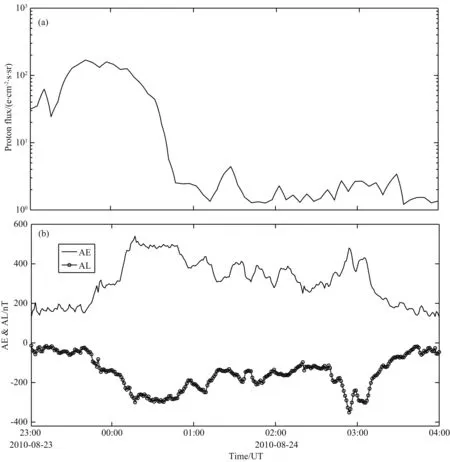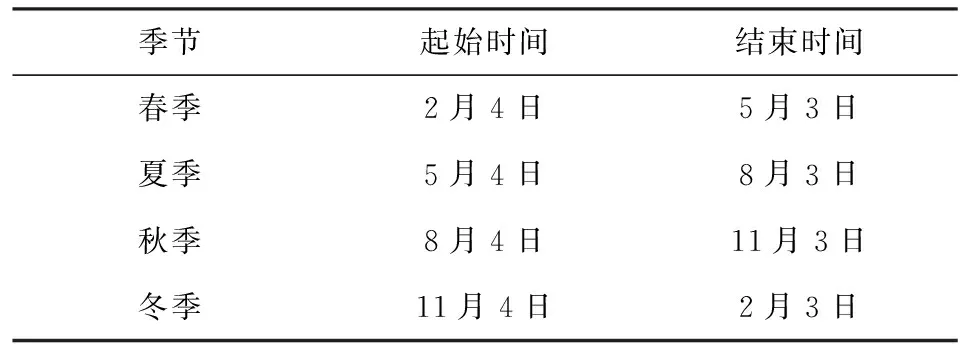基于CARISMA地磁台链观测的IPDP事件的统计分析
2015-03-16周铭霞袁志刚李海梦王德栋余雄东王贞贞乔铮
周铭霞, 袁志刚, 李海梦, 王德栋, 余雄东, 王贞贞, 乔铮
武汉大学电子信息学院, 武汉 430072
基于CARISMA地磁台链观测的IPDP事件的统计分析
周铭霞, 袁志刚*, 李海梦, 王德栋, 余雄东, 王贞贞, 乔铮
武汉大学电子信息学院, 武汉 430072
亚暴期间磁尾等离子体片离子注入内磁层能够激发电磁离子回旋(EMIC)波.对应于这种EMIC波,地面磁力仪可观测到周期逐渐减小的地磁脉动(IPDP).利用GOES卫星数据,地磁指数和加拿大CARISMA地磁台站的数据,我们研究了IPDP事件的产生与亚暴磁尾注入的关系.同时利用CARISMA地磁台链中的MCMU和MSTK两个台站,从2005年4月到2014年5月期间的观测数据,统计分析了亚暴期间的IPDP事件,研究了IPDP事件的出现率关于季节和磁地方时的分布特征.我们总共获得128个两个台站同时观测的IPDP事件.该类事件关于季节分布的发生率,冬季最小,为13.28%,春季最大,为32.81%,结果表明IPDP事件关于季节分布的发生率受到电离层电导率及亚暴发生率的影响.两个台站同时观测到的IPDP事件最大出现率出现在15—18 MLT(磁地方时),结果表明IPDP事件主要由亚暴期间产生的能量离子注入内磁层,西向漂移遇到等离子体层羽状结构(Plume)区的高密度等离子体所激发.
电磁离子回旋波; 周期逐渐减小的地磁脉动; 亚暴注入; 发生率
1 引言
电磁离子回旋(EMIC)波,由高能离子温度各向异性(T⊥>T∥)导致的离子回旋不稳定性所激发.EMIC波的频带范围为0.1~5 Hz的是Pc1-2波 (Halford et al., 2010).EMIC波在快速离子加热,冷电子加热,投掷角散射和沉降导致的环电流衰减和辐射带相对论电子快速损失方面起到非常重要的作用 (Jordanova et al., 2001, Fok et al., 2005, Fraser et al., 2012, Su et al., 2010, 2011, Xiao et al., 2011, Yuan et al., 2013, 2014, Zhou et al., 2013, Wang et al., 2014),因此研究EMIC在磁层中的表现特征和发生率非常重要.在磁暴期间,等离子体层或等离子体羽状结构(plume)的高密度冷等离子体,降低产生环电流离子回旋不稳定性的门限,从而有利于激发EMIC波 (Cornwall, 1965, Fraser et al., 2005, Liu et al., 2012, Yuan et al., 2012a, 2012b).等离子体层plume形成于磁暴期间等离子体层黄昏侧,而且可从黄昏侧向日侧磁层顶延伸.不仅等离子体层plume还有等离子体层顶这些高密度梯度区域都有利于EMIC波的产生与传播 (Yuan et al., 2010, Yuan et al., 2012a).磁尾等离子体注入的高能质子西向漂移遇到等离子体层或等离子体层黄昏隆起时,易激发EMIC波(Hayakawa et al., 1992).在冷等离子体里沿着地磁场平行传播的EMIC波的色散关系表明,相互作用的高能质子的平行能量在磁赤道有一个最小值,所以磁赤道区域有利于EMIC波的产生 (Lee and Kwok, 1984, Loto′aniu et al., 2005).磁赤道激发的EMIC波可沿磁力线传播到电离层,从而被地磁台站观测到Pc1-2波动(Lee et al., 1984, Loto′aniu et al., 2005).
根据Pc1-2在功率谱中的形态,Pc1-2可大致分为两类.第一类是结构型或珠型脉动,这一类事件都具有周期性调制波幅, 其他大多事件归为第二类,即非结构型脉动 (Kerttula et al., 2001).周期逐渐减小的地磁脉动(IPDP)就是典型的非结构型的Pc1-2现象.它最显著的特征在于它的频率漂移,而且这个特点的出现与亚暴的发生紧密相关(Saito, 1969, Gendrin, 1971, Gul′elmi, 1974).在功率谱图中IPDP事件存在着明显的频率增长,而且占据一个比较宽的频带.IPDP通常在亚暴开始后的下午或傍晚被观测到 (Lee and Kwok, 1984).通常 IPDP事件发生之前,都存在一个AE指数的增长,并且IPDP波事件的开始时间与AE指数开始增长的时刻相差0.5~2 h (Hayakawa et al., 1992).以往的研究只有少数短期观测的统计分析,研究主要集中在IPDP事件的事例分析.本文选取了MCMU和MSTK两个台站从2005年4月到2014年5月这10年间同时观测到的IPDP事件做了统计分析,研究IPDP事件的发生率关于磁地方时(MLT)及季节分布的统计特征.
2 探测仪器
Canadian Array for Realtime Investigation of Magnetic Activity(CARISMA)是加拿大地球空间监测系统工程(Canadian Geospace Monitoring)的磁力仪监测部分.它是一个位于北美大陆,用于测量地磁场的磁力仪设备阵列.我们选取了CARISMA台链中的Fort McMurray(MCMU) 和Ministik Lake(MSTK)两个台站的磁通门磁力仪(FGM)的观测数据,它们的地理位置分别为(56.65°N,248.79°E)和(53.351°N,247.026°E),L值分别为5.35和4.22.这两个台站在磁赤道平面的投影一般处于等离子体层顶附近,非常有利于观测等离子体层顶附近的EMIC波事件.我们利用FGM的高分辨率(8 Hz)的数据进行了IPDP事件分析.
Geostationary Operational Environmental Satellite(GOES)卫星位于地球同步轨道(L=6.6),GOES卫星携带的高能粒子传感器(Energetic Particle Sensor, EPS)为我们提供了高能粒子通量数据来研究高能离子注入事件.EPS的观测方向是垂直于GOES的自转轴,且GOES的自转轴与地球的自转轴线大致对齐.EPS探测的高能质子通量数据为5 min平均值.同时结合地磁指数AE, AL进行了事例分析.
3 典型事例分析
我们根据GOES卫星的质子通量数据,同时利用地磁指数AE, AL,确定磁尾亚暴期间等离子体片离子注入内磁层事件,再利用MCMU和MSTK两个地磁台站的FGM的高分辨率(8 Hz)数据,研究两个台站同时观测到的IPDP事件与亚暴离子注入事件的关系.
图1a显示的是从2010年8月23日到24日时间段GOES 11卫星探测的质子通量的变化,图1b显示的是这两天的AE, AL指数的变化.如图1所示,在2010年8月23日23∶20 UT(14∶26 MLT),质子通量有一个快速的增长.同时,AE指数在之前也一直没有太大变化,直到2010年8月23日23∶35 UT突然有一个大的增长.为了更好地显示GOES 11卫星测量的质子通量的变化与AE, AL指数变化之间的对应关系,如图2显示的是图1从2010年8月23日23∶00 UT到2010年8月24日04∶00 UT时间段,即图1中两条黑色竖线标注的时间段内的质子通量与AE指数的变化.由图2可知在23∶35 UT时AE指数有一个快速增长.通过研究AE, AL指数的变化我们可以确定在2010年8月23日23∶35 UT有亚暴发生,质子通量从23∶20 UT开始也有一个大的增长,所以可以确定此时有亚暴离子注入事件产生.

图1 2010年8月23日到2010年8月24日质子通量(a)和AE,AL指数(b)的变化 (图中左边的黑色竖线是亚暴起始,同时质子通量有增长)Fig.1 (a) and (b) the variation of proton flux and AE,AL indices between 23th August 2010 and 24th August 2010, and the left side of black marked line represent the onset of substorm, the same time proton flux has an increase
地磁分量Bx的实际测量值减去它的滑动平均值之后(滑动窗的长度为128 s)可得出扰动量(ΔBx),图3是根据扰动量(ΔBx)经过计算得到的功率频谱图和原始曲线图.由图3可知,MCMU和MSTK两个台站同时观测到的一个Pc1-2事件.该事件发生于2010年8月24日00∶35 UT (16∶15 MLT),事件持续时间段为00∶35—01∶10 UT.由于两个台站观测到的Pc1-2事件都明显存在频率随时间的增长,即在频谱形态上有一定的斜率,因此我们确定这个Pc1-2事件为一个同时观测的IPDP事件.MCMU和MSTK两个台站同时观测的IPDP事件在形态上有些差异,其频率漂移的斜率在MSTK观测大于在MCMU观测,这可能是由于波动的源区移动及源区与地磁观测台站的相对位置造成的.图3b功率谱图中MSTK地磁台站在2∶00—3∶00 UT也观测到Pc1-2事件,这也是IPDP事件,但在图3a中MCMU却没有观测到.这可能是由于IPDP波动产生的源区距离MCMU地磁台站太远,IPDP波动在电离层波导传输过程中衰减,导致未被MCMU台站观测到.
图1—3的研究显示,在IPDP事件发生之前,AE指数快速增长,且GOES 11卫星也观测到质子通量快速增长,说明这个IPDP事件是由磁尾亚暴期间等离子体片离子注入内磁层后西向漂移,激发EMIC波产生的.

图2 GOES 11的质子通量数据(a)和AE,AL指数(b)在2010年8月23日 23∶00 UT 到2010年8月24日04∶00 UT的变化Fig.2 The variation of proton flux from GOES 11 and AE, AL indices between 23∶00 UT 23th August 2010 and 04∶00 UT 24th August 2010

图3 MCMU(A)和MSTK(B)在2010年8月24日的同时观测到的IPDP事件Fig.3 (A) and (B) represent the IPDP wave event simultaneously observed by MCMU and MSTK in 24th August 2010
4 统计结果
我们挑选了MCMU和MSTK两个台站从2005年4月到2014年5月时间段内同时观测到的Pc1-2事件.当两个台站同时观测的功率谱中存在大于0.1 Hz的频带信号并且振幅明显大于背景平均振幅值,频率有一个明显的增长时,就判断为一个有效的IPDP观测事件,并且记录下每个IPDP事件持续的时间段.将MLT划分为8个时间段,分别为:0—3 MLT, 3—6 MLT, 6—9 MLT, 9—12 MLT,12—15 MLT, 15—18 MLT, 18—21 MLT, 21—24 MLT. 分别计算IPDP事件落在这8个MLT时间段的发生率.统计季节发生率时,季节的划分如表1.

表1 季节的划分Table 1 The definition of the season
我们所用的FGM数据是两个地磁台站从2005年4月到2014年5月这10年间的同时观测数据,通过统计分析获得IPDP事件发生率关于MLT和季节分布的统计特征.我们总共挑选了128个同时观测的IPDP事件.图4a说明两个台站的同时观测到的IPDP事件可以发生在所有的MLT,但是最大发生率在15—18 MLT时间段.在不同季节,IPDP事件的发生率也有所不同.如图4b所示最小的季节发生率在冬季,为13.28%,春夏秋都比较大,其中春季发生率最大,为32.81%.
5 讨论与结论
EMIC波产生于磁赤道区域,由高能离子温度的各向异性导致的离子回旋不稳定性所激发.图4a显示IPDP事件可以发生在所有的磁地方时,但是在15—18 MLT时间段发生率最大.在不同的季节,IPDP事件的发生率也有所不同,如图4b所示,春夏秋都比较大,其中春季最大,达到32.81%,但在冬季发生率最小,仅为13.28%.图4a显示IPDP事件的日发生率在15—18 MLT时间段呈现峰值,可能是因为离子回旋不稳定区域的西向漂移质子遇到高密度的等离子体层plume区或等离子体层顶都有利于产生EMIC波,等离子体层plume多形成于黄昏侧,并向日侧延伸(Yuan et al., 2010,Yuan et al., 2012b),所以IPDP事件多出现在黄昏侧(Lee and Kwok, 1984, Hayakawa et al., 1992).而且MCMU和MSTK的L值分别为5.35和4.22,是经常观测到等离子体层plume所在的L值范围,所以在15—18 MLT观测到的IPDP事件较多,发生率高.根据上述图4b可看出IPDP的季节分布特征,一是在冬季发生率最低,仅为13.28%,二是春夏秋发生率都比较大,其中春季发生率最高,达到32.81%.这可能与EMIC波的传播有关系.EMIC波沿地球磁力线从磁层传播到电离层E层并且向四周传播.EMIC波在电离层波导中传播时,电离层的电导率起着非常重要的作用.当缺少光照时,电离程度低,电导率小,不利于Pc1-2传播 (Kim et al., 2011; 邱奕婷等,2014).CARISMA地磁台链位于北美大陆,冬季缺少光照,因此IPDP波事件在冬季较少,发生率低.而在夏季由于在北美大陆光照强,电离程度高,电离层电导率大,有利于IPDP波的传播,所以夏季IPDP事件多,发生率高.但从图4b可以看出IPDP事件在春秋季发生率也比冬季高,而且在春季的发生率最高,秋季的发生率分别低于春季和夏季.这可能是因为在春分、秋分时地磁活动增强所致(Saito, 1969).亚暴的强度和地磁活动有一个显著的年变化,二分点的最大值在春季和秋季之间变化(Mursula et al., 2011).图5显示的是从2005年4月到2014年5月时间段内春夏秋冬各季节内Kp指数大于3的数据点数的归一化出现率.由图5可知,Kp指数关于季节的归一化出现率是春季高于夏季,夏季高于秋季,秋季高于冬季.因此春季的亚暴强度和地磁活动比秋季强,磁尾等离子体片离子注入事件多,利于IPDP波动的产生,所以春季的发生率高于秋季.同时可能因为春秋季的电离层电导率一般明显小于夏季,不利于波动的传播,且秋季的亚暴强度和地磁活动比春季弱,磁尾等离子体片离子注入事件没有春季多,所以秋季的发生率低于夏季.综上所述说明IPDP事件关于季节分布的发生率同时受到电离层电导率和亚暴发生率的影响.

图4 MCMU和MSTK 两个台站同时观测的IPDP事件关于MLT(a)和季节(b)的分布Fig.4 (a) and (b) represent the occurrence rate distribution of IPDP event simultaneously observed by MCMU and MSTK in MLT and season respectively

图5 2005年4月到2014年5月时间段内Kp指数 大于3 的数据点数关于季节的归一化出现率Fig.5 From April 2005 until May 2014, normalized rate distribution of Kp>3 in season
基于GOES卫星、加拿大CARISMA地磁台站的联合观测数据,本文研究了IPDP事件的产生与亚暴磁尾注入的关系.同时,利用CARISMA地磁台链中的MCMU和MSTK两个台站,从2005年4月到2014年5月期间的观测数据,统计分析了亚暴期间的IPDP事件,研究了IPDP事件的出现率关于季节和磁地方时的分布.统计结果表明:IPDP事件关于季节分布的发生率,冬季最小,春季最大.IPDP事件关于季节分布的发生率受到电离层电导率及亚暴发生率的影响.两个台站同时观测到的IPDP事件最大出现率出现在15—18 MLT,结果表明IPDP事件主要由亚暴期间产生的高能离子注入内磁层,西向漂移遇到等离子体层羽状结构区的高密度等离子体所激发.
致谢 本文所用GOES 11卫星数据来源于NASA Space Physics Data Facility(http:∥spdf.gsfc.nasa.gov/)网站下载的, 地磁指数数据来源于Geomagnetic Data service (http:∥wdc.kugi.kyoto-u.ac.jp/wdc/Sec3.html).本文所用FGM的数据来源于CARISMA.
Cornwall J M. 1965. Cyclotron instabilities and electromagnetic emission in the ultra low frequency and very low frequency ranges.J.Geophys.Res., 70(1): 61-69, doi: 10.1029/JZ070i001p00061.Fok M C, Ebihara Y, Moore T E, et al. 2005. Geospace storm processes coupling the ring current, radiation belt and plasmasphere. ∥ Burch J, Schulz M, Spence H eds. Inner Magnetosphere Interactions: New Perspectives from Imaging. Geophys. Monogr. Ser., AGU, Washington, D. C., 159, 207-220, doi: 10.1029/159GM16.Fraser B J, Singer H J, Adrian M L, et al. 2005. The relationship between plasma density structure and EMIC waves at geosynchronous orbit. ∥Burch J, Schulz M, Spence H eds. Inner Magnetosphere Interactions: New Perspectives from Imaging, Geophys. Monogr. Ser., AGU, Washington, D. C.,159: 55-70, doi: 10.1029/159GM04.Fraser B J, Morley S K, Grew R S. 2012. Classification of Pc1-2 electromagnetic ion cyclotron waves at geosynchronous orbit. ∥Summers D, Mann I R, Baker D N, et al, eds. Dynamics of the Earth′s Radiation Belts and inner Magnetosphere, AGU, Washington, D.C., doi: 10.1029/2012GM001353
Gendrin R. 1971. Substorm aspect of magnetic pulsations.SpaceSci.Rev., 11(1): 54-130.
Gul′elmi A V. 1974. Diagnostics of the magnetosphere and interplanetary medium by means of pulsations.SpaceSci.Rev., 16(3): 331-345.
Halford A J, Fraser B J, Morley S K. 2010. EMIC wave activity during geomagnetic storm and nonstorm periods: CRRES results.J.Geophys.Res., 115: A12248, doi: 10.1029/2010JA015716.Hayakawa M, Shimakura S, Kobayshi T, et al. 1992. A study of polarization of irregular pulsations of diminishing period and their generation mechanism.Planet.SpaceSci., 40(8): 1081-1091.Jordanova V K, Farrugia C J, Thorne R M, et al. 2001. Modeling ring current proton precipitation by electromagnetic ion cyclotron waves during the May 14-16, 1997, storm.J.Geophys.Res., 106(A1): 7-22, doi: 10.1029/2000JA002008.
Kerttula R, Mursula K, Pikkarainen T, et al. 2001. Storm-time Pc1 activity at high and middle latitudes.J.Geophys.Res., 106(A4): 6213-6227, doi: 10.1029/2000JA900125.
Kim H, Lessard M R, Engebretson M J, et al. 2011. Statistical study of Pc1-2 wave propagation characteristics in the high-latitude ionospheric waveguide.J.Geophys.Res., 116: A07227, doi: 10.1029/2010JA016355.
Lee L C, Kwok Y C. 1984. A mechanism for the IPDP pulsations.J.Geophys.Res., 89(A2): 877-882, doi: 10.1029/JA089iA02p00877.Liu Y H, Fraser B J, Menk F W. 2012. Pc2 EMIC waves generated high off the equator in the dayside outer magnetosphere.Geophys.Res.Lett., 39: L17102, doi: 10.1029/2012GL053082.
Loto′aniu T M, Fraser B J, Waters C L. 2005. Propagation of electromagnetic ion cyclotron wave energy in the magnetosphere.J.Geophys.Res., 110: A07214, doi: 10.1029/2004JA010816.Mursula K, Tanskanen E, Love J J. 2011. Spring-fall asymmetry of substorm strength, geomagnetic activity and solar wind: Implications for semiannual variation and solar hemispheric asymmetry.Geophys.Res.Lett., 38, L06104, doi: 10.1029/2011GL046751.Qiu Y T, Liu Y H, Zhao H F. 2014. Statistical characteristics of Pc1-2 waves near the cusp latitudes.AdvancesinPolarScience(in Chinese), 26(3): 324-330.
Saito T. 1969. Geomagnetic pulsations. Space Sci. Rev., 10: 319-412, doi: 10.1007/BF00203620.
Su Z P, Xiao F L, Zheng H N, et al. 2010. STEERB: A three dimensional code for storm-time evolution of electron radiation belt.J.Geophys.Res., 115: A09208, doi: 10.1029/2009JA015210.Su Z P, Xiao F L, Zheng H N, et al. 2011. CRRES observation and STEERB simulation of the 9 October 1990 electron radiation belt dropout event.Geophys.Res.Lett., 38: L06106, doi: 10.1029/2011GL046873.
Wang Z Z, Yuan Z G, Li M, et al. 2014. Statistical characteristics of EMIC wave driven relativistic electron precipitation with observations of POES satellites: Revisit.J.Geophys.Res.SpacePhysics, 119(7): 5509-5519, doi: 10.1002/2014JA020082.Xiao F L, Chen L X, He Y H, et al. 2011. Modeling for precipitation loss of ring current protons by electromagnetic ion cyclotron waves.J.Atmos.Sol.Terr.Phys., 73(1): 106-111, doi: 10.1016/j.jastp.2010.01.007.
Yuan Z G, Deng X H, Lin X, et al. 2010. Link between EMIC waves in a plasmaspheric plume and a detached sub-auroral proton arc with observations of Cluster and IMAGE satellites.Geophys.Res.Lett., 37: L07108, doi: 10.1029/2010GL042711.
Yuan Z G, Xiong Y, Pang Y, et al. 2012a. Wave-particle interaction in a plasmaspheric plume observed by a Cluster satellite.J.Geophys.Res., 117: A03205, doi: 10.1029/2011JA017152.
Yuan Z G, Xiong Y, Wang D D, et al. 2012b. Characteristics of precipitating energetic ions/electrons associated with the wave-particle interaction in the plasmaspheric plume.J.Geophys.Res., 117: A08324, doi: 10.1029/2012JA017783.
Yuan Z G, Li M, Xiong Y, et al. 2013. Simultaneous observations of precipitating radiation belt electrons and ring current ions associated with the plasmaspheric plume.J.Geophys.Res.SpacePhysics, 118(7): 4391-4399, doi: 10.1002/jgra.50432.
Yuan Z G, Xiong Y, Huang S Y, et al. 2014. Cold electron heating by EMIC waves in the plasmaspheric plume with observations of the Cluster satellite.Geophys.Res.Lett., 41(6): 1830-1837, doi: 10.1002/2014GL059241.
Zhou Q H, Xiao F L, Yang C, et al. 2013. Observation and modeling of magnetospheric cold electron heating by electromagnetic ion cyclotron waves.J.Geophys.Res.SpacePhysics, 118(11): 6907-6914, doi: 10.1002/2013JA019263.
附中文参考文献
邱奕婷, 刘勇华, 赵浩峰. 2014. 极隙区纬度Pc1-2波的统计分布特征. 极地研究, 26(3): 324-330.
(本文编辑 汪海英)
Statistical study of IPDP events observed by the CARISMA network of magnetometers
ZHOU Ming-Xia, YUAN Zhi-Gang*, LI Hai-Meng, WANG De-Dong,YU Xiong-Dong, WANG Zhen-Zhen, QIAO Zheng
SchoolofElectronicInformation,WuhanUniversity,Wuhan430072,China
During substorms energetic ions injected from the magnetotail plasma sheet can excite electromagnetic ion cyclotron (EMIC) waves in the inner magnetosphere. As a signature of EMIC waves, the interval of pulsations of diminishing periods (IPDP) is observed by ground-based magnetometers. The generating mechanism of IPDP waves is closely associated with substorm injected energetic ions during substorms. In addition, the occurrence rate of IPDP waves in the inner magnetosphere is very important to study the dynamics of the magnetosphere.Firstly, with observations of magnetometers at MCMU and MSTK stations of CARISMA network in Canada and the GOES 11 satellite for the typical IPDP events, the relationship between IPDP and the energetic ions injected from the magnetotail plasma sheet during substorms was revealed. Then based on the observations of magnetometers at MCMU and MSTK stations of CARISMA network between April 2005 and May 2014, we statistically analyzed the occurrence rate distribution of IPDP events in seasons and magnetic local time (MLT).The results for the typical case show that during substorms, energetic ions injected from the magnetotail plasma sheet can excite IPDP waves in the inner magnetosphere. For the statistics, a total of 128 IPDP wave events have been simultaneously observed by both MCMU and MSTK stations. The maximum occurrence rate of the events is between 15 MLT and 18 MLT, corresponding to the region of plasmasphere plumes. The IPDP events have the least occurrence rate in winter (13.28%), the highest occurrence rate is in spring (32.81%). The least occurrence rate in winter should be related to the ionospheric conductivity while the highest in spring is associated with the spring-autumn asymmetry of substorm and geomagnetic activity.The case study and statistics show that IPDP events are mainly generated by energetic protons, which can be injected into the inner magnetosphere during substorms and drift westward and encounter the plasmaspheric plume. In addition, the occurrence rate of IPDP events is affected by the ionospheric conductivity and the occurrence rate of substorms.
EMIC; IPDP; Substorm injection; Occurrence rate
10.6038/cjg20150702.
国家自然科学基金(41174140,41221003,41374168), 高等学校博士点基金(20110141110043), 新世纪优秀人才项目(NCET-13-0446)共同资助.
周铭霞,女,1989年生,硕士研究生,主要从事电离层磁层物理方面的研究.E-mail: mingxiazhou@whu.edu.cn
*通讯作者 袁志刚, 男,1974年生,教授,主要从事电离层磁层耦合方面的研究.E-mail: y_zgang@vip.163.com
10.6038/cjg20150702
P352
2014-10-13,2015-06-19收修定稿
周铭霞,袁志刚,李海梦等. 2015. 基于CARISMA地磁台链观测的IPDP事件的统计分析.地球物理学报,58(7):2235-2241,
Zhou M X, Yuan Z G, Li H M, et al. 2015. Statistical study of IPDP events observed by the CARISMA network of magnetometers.ChineseJ.Geophys. (in Chinese),58(7):2235-2241,doi:10.6038/cjg20150702.
